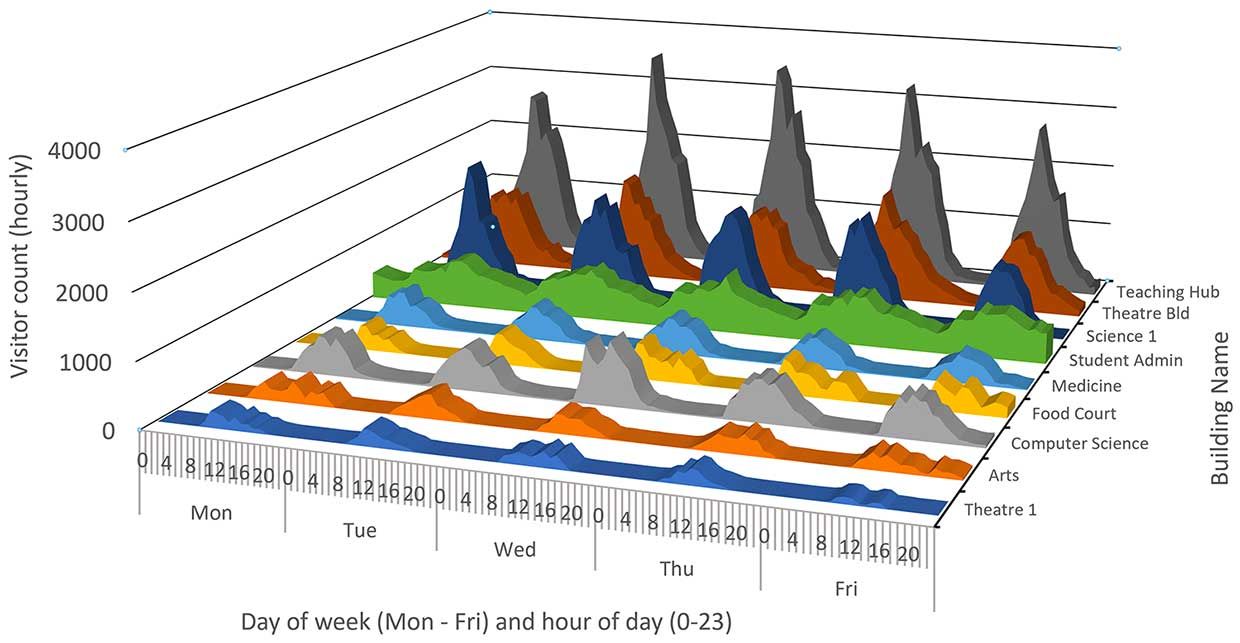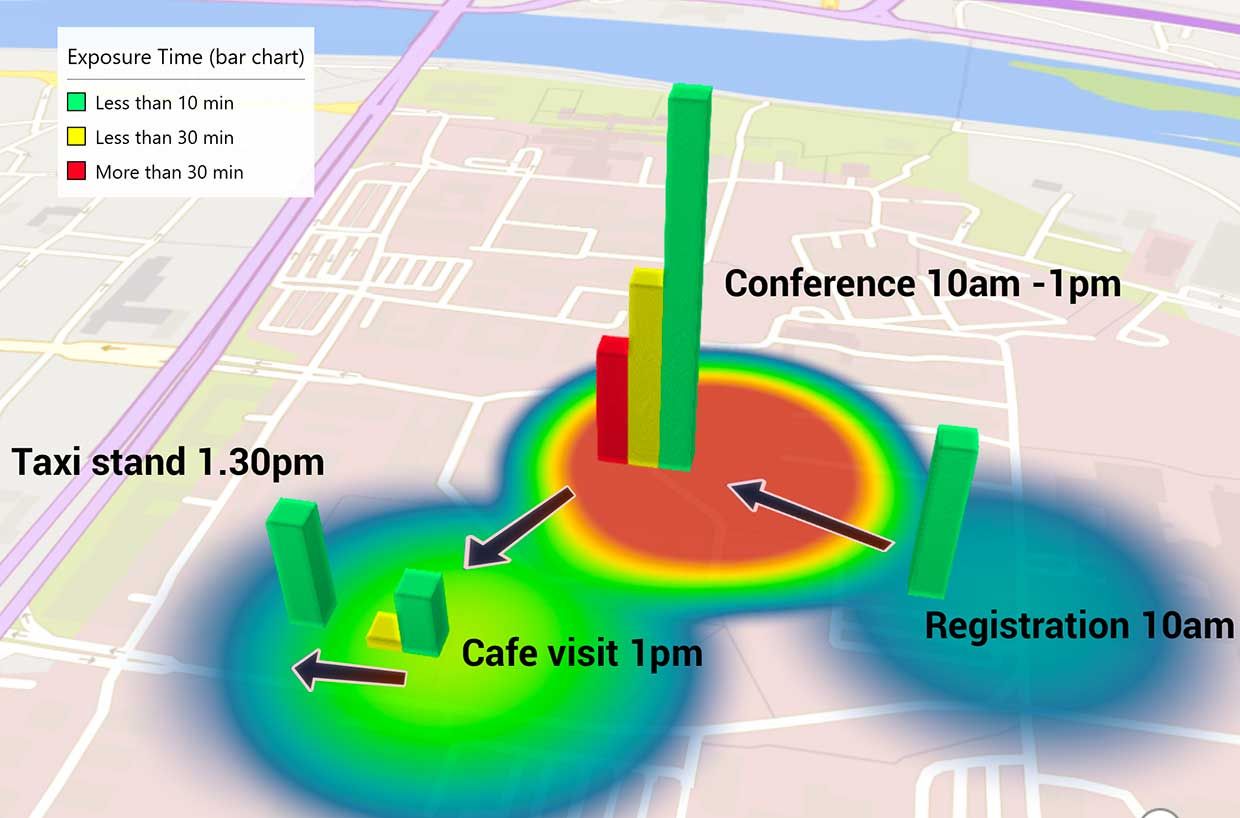How To Use Wi-Fi Networks To Ensure a Safe Return to Campus

This is a guest post. The views expressed here are solely those of the authors and do not represent positions of IEEE Spectrum or the IEEE.
Universities, together with other operators of large spaces like shopping malls or airports, are currently facing a dilemma: how to return to business as fast as possible, while at the same time providing a safe environment?
Given that the behavior of individuals is the driving factor for viral spread, key to answering this question will be understanding and monitoring the dynamics of how people move and interact while on campus, whether indoors or outdoors.
Fortunately, universities already have the perfect tool in place: the campus-wide Wi-Fi network. These networks typically cover every indoor and most outdoor spaces on campus, and users are already registered. All that needs to be added is data analytics to monitor on-campus safety.
We, a team of researchers from the University of Melbourne and the startup Nexulogy, have developed the necessary algorithms that, when fed data already gathered by campus Wi-Fi networks, can help keep universities safe. We have already tested these algorithms successfully at several campuses and other large yet contained environments.
 Image: Jan Dethlefs/Nexulogy Analysis of Wi-Fi data over the course of a week allows university managers to identify times and places where occupancy levels could be problematic during the pandemic.
Image: Jan Dethlefs/Nexulogy Analysis of Wi-Fi data over the course of a week allows university managers to identify times and places where occupancy levels could be problematic during the pandemic. To date, little attention has been paid to using Wi-Fi networks to track social distancing. Countries like Australia have rolled out smartphone apps to support contact tracing, typically using Bluetooth to determine proximity. A recent Google/Apple collaboration, also using Bluetooth, led to a decentralized protocol for contact monitoring.
Yet the success of these apps mainly relies on people voluntarily downloading them. A study by the University of Oxford estimated that more than 70 percent of smartphone users in the United Kingdom would have to install the app for it to be effective. But adoption is not happening at anything near that scale; the Australian COVIDSafe app, for example, released in April 2020, has only been downloaded by 6 million people by mid-June 2020, or about 24 percent of the population.
Furthermore, this kind of Bluetooth-based tracking does not relate the contacts to a physical location, such as a classroom. This makes it hard to satisfy the requirements of running a safe campus. And data collected by the Bluetooth tracking apps is generally not readily available to the campus owners, so it doesn't help make their own spaces safer.
Our Wi-Fi based algorithms provide the least privacy-intrusive monitoring mechanisms thus far, because they use only anonymous device addresses; no individual user names are necessary to understand crowd densities and proximity. In the case of a student or campus staff member reporting a positive coronavirus test, the device addresses determined to belong to someone at risk can be passed on authorities with the appropriate privacy clearance. Only then would names be matched to devices, with people at risk informed individually and privately.
Wi-Fi presents the best solution for universities for a couple of reasons: wireless coverage is already campus wide; it is a safe assumption that everyone on campus is carrying at least one Wi-Fi capable device; and virtually everyone living and working on campus registers their devices to have internet access. Such tracking is possible without onerous user-facing app downloads.
Often university executives already have the rights to use the information collected in the wireless system included as part of its Terms and Conditions. In the midst of this pandemic, they now also have a legal or, at least a moral obligation, to use such data to their best ability to improve safety and well-being of everyone on campus.
 Image: Jan Dethlefs/Nexulogy Using Wi-Fi data, algorithms calculate the population density for specific spaces on campus at particular times.
Image: Jan Dethlefs/Nexulogy Using Wi-Fi data, algorithms calculate the population density for specific spaces on campus at particular times. The process starts by collecting the time and symbolic location (also known as network access point) of Wi-Fi capable devices when they are first detected by the Wi-Fi infrastructure, for example, when a student enters the campus' Wi-Fi environment, and then during regular intervals or when they change locations. Then, after consolidating any multiple devices of a single user, our algorithms calculate the number of occupants in a given area. That provides a quick insight into crowd density in any building or outdoor plaza.
Our algorithms can also reconstruct the journey of any user within the Wi-Fi infrastructure, and from that can derive exposure time to other users, spaces visited and transmission risk.
This information lets campus managers do several things. For one, our algorithms can easily identify high risk areas by time and location and flag areas where social distance limits are regularly exceeded. This helps campus managers focus resources on areas that may need more hand sanitizers or more frequent deep cleaning.
For another, imagine an infected staff member has been identified by public health authorities. Based on the health authorities' request, the university can identify possible infection pathways by tracking the individual's journeys through the campus. It is possible to backtrack the movement history since the start of the data collection, for days or even weeks if necessary.
To illustrate the methodology, we assumed one of us had a COVID infection and we reconstructed his journey and exposure to other university visitors during a recent visit to a busy university campus. In the heat map below, you can see that only the conference building showed a significant number of contacts (red bar) with an exposure time of, in this example, more than 30 minutes. While we only detected other individuals by Wi-Fi devices, the university executives could now notify people that potentially have been exposed to an infectious user.
 Image: Jan Dethlefs/Nexulogy To illustrate the capabilities of our approach the journey of one of the authors was tracked during the attendance of a conference. The author arrived at 10am passing multiple people. The conference building was busy at the time, but the author was exposed to only around 30 people for a longer period (red bar). After the conference the author picked up coffee on the way out and encountered a small number of people while queueing (yellow). While waiting for a taxi a small number of people walked past, all with exposure time of less than 10 minutes.
Image: Jan Dethlefs/Nexulogy To illustrate the capabilities of our approach the journey of one of the authors was tracked during the attendance of a conference. The author arrived at 10am passing multiple people. The conference building was busy at the time, but the author was exposed to only around 30 people for a longer period (red bar). After the conference the author picked up coffee on the way out and encountered a small number of people while queueing (yellow). While waiting for a taxi a small number of people walked past, all with exposure time of less than 10 minutes. This system isn't without technical challenges. The biggest problem is noise in the system that needs to be removed before the data is useful.
For example, depending on the building layout and wireless network configurations, wireless counts inside specific zones can include passing outside traffic or static devices (like desktop computers). We have developed algorithms to eliminate both without requiring access to any user information.
Even though the identification and management of infection risks is limited to the area covered by the wireless infrastructure, the timely identification of a COVID event naturally benefits areas beyond the campus. Campuses, and even residential campuses in lockdown, have a daily influx of external visitors -staff, contractors, and family members. Those individuals could be identified via telecommunication providers if requested by health authorities.
In the case of someone on campus testing positive for the virus, people they came in contact with, their contact times and places they went to can be identified within minutes. This allows the initiation of necessary measures (e.g. COVID testing or decontamination) in a targeted, timely and cost-effective way.
Since the analytics can happen in the cloud, the software can easily be updated to reflect on new or refined medical knowledge or health regulations, say a new exposure time threshold or physical distancing guidelines.
Privacy is paramount in this process. Understanding population densities and crowd management is done anonymously. Only in the case of someone on campus reporting a confirmed case of the coronavirus do authorities with the necessary privacy clearance need to connect the devices and the individuals. Our algorithm operates separately from the identification and notification process.
As universities around the world are eager to welcome students back to the campus, proactive plans need to be in place to ensure the safety and wellbeing of everyone. Wi-Fi is available and ready to help.
Jan Dethlefs is a data scientist and Simon Wei is a data engineer, both at Nexulogy in Melbourne, Australia. Stephan Winter is a professor and Martin Tomko is a senior lecturer, both in the Department of Infrastructure Engineering at the University of Melbourne, where they work with geospatial data analytics.
< Back to IEEE COVID-19 Resources